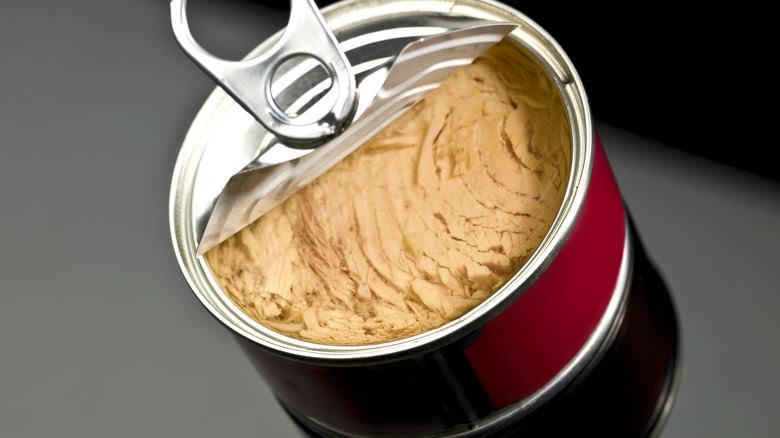The USDA Explains How To Properly Store Canned Tuna So It Doesn't Make You Sick
Canned tuna is a convenient way to get a healthy, low-fat serving of protein while also getting docosahexaenoic acid (DHA) to improve your brain and eyes. These days, you don't even need a can opener because brands of canned tuna now offer tuna in single-serve pouches.
Whether you mix your tuna with a little mayo for a sandwich or top it with cheese for a tuna melt, you could have a little left over, depending on the size of the can. Obviously, you know it would be a bad idea to put the can back into the pantry or set it on the counter. Bacteria grow pretty quickly on food between 40 and 140 degrees Fahrenheit, according to the United States Department of Agriculture (USDA). Eating food that's been sitting on the table or counter for two hours (or more) can make you more susceptible to foodborne illness. The USDA says that 48 million people each year develop a foodborne illness from food that hasn't been cooked enough or hasn't been stored at the proper temperature. As soon as you're done preparing or cooking your canned tuna, you'll need to store it in a refrigerator set to 40 degrees or colder.
Storing leftover canned tuna in the refrigerator
If you have leftover tuna that's still in the can, the USDA says you can store the can itself in the refrigerator. To preserve the flavor of your tuna, you'll probably want to seal it in a glass or plastic container. Any opened can of tuna can last between three and four days in the refrigerator. However, the Academy of Nutrition and Dietetics says once moisture, light, and air get to the tuna, it has the potential for spoilage. It suggests eating the tuna within one or two days after opening it.
If you've made a tuna casserole that's still hot from the oven, divide it into smaller portions before you refrigerate it. That way it will cool much more quickly. You can also store leftovers in the freezer for about three or four months. Be mindful that freezing food takes out much of the moisture.
Before eating any leftover tuna in the refrigerator, check to see if there's any evidence of spoilage. The Kitchen Community says to check the smell for any foul (rather than fishy) odor. If the tuna develops an off-brown color or looks slimy, throw it out.
Storing unopened canned tuna in the pantry
The Kitchen Community says that even if you do your best to keep canned tuna from spoiling, the tuna could have been spoiled before you open it. You'll want to store canned tuna in a pantry or any place that's away from direct sunlight or any heat source. Cans of tuna have expiration dates, so be sure to check them often if the cans have been sitting in the pantry. It's also not a bad idea to put the older cans toward the front of your pantry so you'll eat them first.
After you've checked the expiration date, take a look at the can itself. Check for mold, dents, bulges, rust, or leaking. Once you open the can, take a whiff. It should smell fishy rather than rancid. Notice if the tuna has a different color or slimy texture. Any cans of tuna that show these signs of spoilage should be thrown out.



